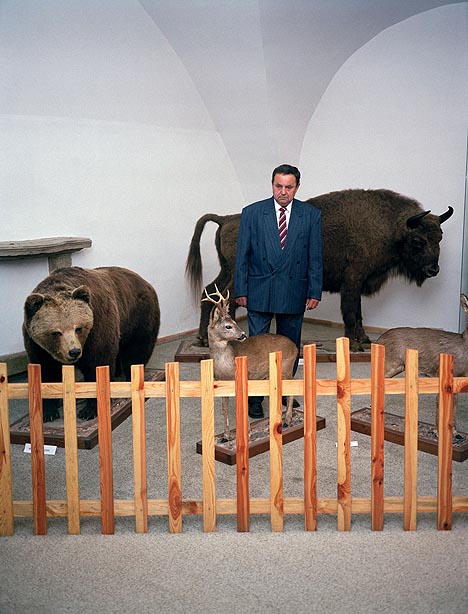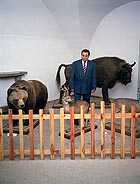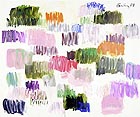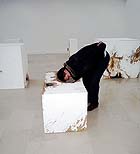
translated and summarized by: Liz Wollner-Grandville,
English summary January 13 - 18
Bank vault of the BA-CA Kunstforum – Lucia Nimcová III
Cow on drugs
A woman breaks an egg into a pan. A girl pulls a piece of chewing gum out of her mouth. A fly whirs around. Why the Czechoslovakian authorities censored these film scenes seems rather puzzling. Lucia Nimcová made a video out of these scenes, where they appear as totally innocuous. But they clearly show the system’s paranoia. A good example is the film about drug prevention: at first there is a long narration on how a cow got hold of hallucinogens and becomes addicted, followed by pictures of wild parties and youths. Nimcová mainly works with archive material, with found footage and photos of, for example, her hometown – a bleak area, whose inhabitants either go hunting or get drunk. A meticulously arranged photo depicts a baby positioned between a gun and antlers; another sits on a table between glasses and bottles, which definitely not filled with apple cider. At another place, Nimcová lets a group of men pose in semblance of an official photograph, and takes a video of the scene - thereby making otherwise nearly imperceptible insecurities visible. Unfortunately, the meaning of a large part of the works shown at this exhibition remains hidden. Art, which deals so intensely with the memories and politics, desperately needs detailed descriptions. But the only text you will find in this presentation is printed in small letters on the invitation; the individual works are not described. One has to research all the information in the catalogue, which, however, also does not have enough concrete details to offer. It is unfortunate, that this aspect was neglected for such an exciting artist.
Nina Schedlmayer
Tresor (bank vault) im BA-CA Kunstforum
1010 Vienna, Freyung 8, until 25.01.09
www.ba-ca-kunstforum.at
Galerie Thoman: Günther Förg, Galerie Widauer: Hubert Kiecol
Strategies of refraction
“What’s that to me” is the title of Hubert Kiecol’s installation (2007) presented in the inner courtyard of the old Tiroler Landhaus. The installation enters into an irritating dialogue with the surrounding baroque architecture. For his current exhibition showing works by the German sculptor, gallery owner Johann Widauer did not want to only have the model for this installation - he is also presenting Kiecol’s more recent glass and steel sculptures in their original size. The absence of mirroring and refraction of facades on their glass surfaces lets them unfold a completely different, and maze-like effect, allowing them to solely concentrate on themselves. Tipped windows, as for example in “Morgen oder Übermorgen” (Tomorrow or the day after tomorrow) simulate an outlook or insight, while only cogitations regarding the reciprocity between architecture and sculpture open up. In the 1980s Kiecol created completely closed miniature houses made of concrete.
Günther Förg’s paintings are characterized by poetry, obviously through his close cooperation with the authors Anrold Stadler or Günther Herburger. The painter reacts to Herburger’s text (on Förg’s artist life) with the “Trilogie der Tatzen” (“Trilogy of the paws” 2008) currently shown by the Gallery Thoman. These works also convey another one of Förg’s artistic passions: the reference to, and the breaking up of art historic positions. In this case Pointillism, which he faces with blurred brush strokes on white canvas or different coloured base coats, as well as with consciously displayed naivety. However, sometimes this does come across as rather robust and not as rhythmical – the implication of playfulness – as suggested in the title - is subject to a sobriety, which has become cumbersome. It tries to draw energy out of the abstraction, for which it doesn’t always find sufficient amounts.
Ivona Jelcic
Hubert Kiecol
Galerie Johann Widauer, Innsbruck, until 31.01. 09
www.widauer.at
Günther Förg – Die Trilogie der Tatzen
Galerie Elisabeth & Klaus Thoman, Innsbruck, until 24.01.09
www.galeriethoman.at
Villa Arson: Mike Nelson – Le Cannibale (Parody, consumption and institutional critique)
Geometry and anarchy
It is not easy to bring destruction into disrepute. On the contrary, artists tirelessly let it revive through repetition. We only seem to get to know the form or the system when it is being destroyed. And ultimately something new is created through the destruction. The perverted dissection of floors, even of entire exhibition halls, can often be seen in art today e.g. by Bonvicini, Sierra or Althamer. This has nothing to do with violence, it has much more to do with empathy, parody, and new creations, if not even with the newly awakened search for the fourth dimension.
Mike Nelson’s work mediates the power of destruction and also of excessive confusion. The British artist’s work oscillates between a space station and a sculpture. “Le Cannibale”, which was nominated for the Turner Prize in 2007, is a more sophisticated version of the installation, which he created in 1999, and which was - in an exhibition at the Hayward Gallery in 2008 - dedicated to the cult-author of horror stories, H.P. Lovecraft. A system of different sized white bases and cubes, with brown ruptures and black holes reminding of wounds, resembles a desolate heap of rubble or a deserted battlefield.
Nelson’s work refers to the past (Smithson, Matta-Clark, Barock) and the present, reality, and literary fiction (Borges). If someone feels like discovering which reality is hidden behind the opened materiality of the white cubes with their dark abyss and eerie gaping openings, can do so without further ado. It is easy and requires quite some flexibility. The visitor then appears in a kind of adventurous physical ridiculousness, something the artist probably aimed at. Instead of simply bemoaning the “Disenchantment of the World” (Weber) and to look out for the islands of magic, Nelson took the eerie, respectively the cannibalistic, and thereby made ousted energies tangible.
Goschka Gawlik
Villa Arson
06105 Nice, 20 av, Stephen Liégeard, until 01.02.09
www.villa-arson.org
Städel Museum: The Master of Flémalle and Rogier van der Weyden
Altered master
Just like everything that started out small and later became world famous, art history also has its heroic phase. And that was the time during which one categorized and determined masters and works en masse, and discovered documents, which enveloped the provenance and the attributions with the verisimilitude of an historic source. And at some point that time was over; the sources used had dried up. Nolens volens, as of that day, art history concentrated on the interpretation and sifting of explanations. Today only very few projects exist, which view their sources critically. The majority of art historical research involves coincidental encounters.
Figurehead of this reorientation is Erwin Panofsky. He considered his publication “Early Netherlandish Painting” (1953) as his crowing achievement – and this brings us to our topic. Because Old Dutch masters are subject ad libitum to all kinds of interpretation. And that is exactly what the exhibition at the Frankfurt Städel Museum is doing - it is devoting itself to the chief witness of inaccuracy and nescience. Jochen Sander and Stefan Kemperdick were the curators, the same two men who had translated Panofsky’s magnum opus, which was published in 2001 by DuMont.
Alone the fact that this unhistorical figure is denoted as the Master of Flémalle is an interpretation that cannot be justified by anything.
The Städel Museum owns the main works by this Master of Flémalle and they are, of course, the core of this exhibit around which elevating works such as the “Mérode Altar” from the Metropolitan Museum and the “Miraflores –Altar” from Berlin are grouped, the latter being ascribed to Rogier van der Weyden - the other artist whose name was made part of the exhibition title.
What can be seen at this presentation is indeed divergent. There is a lyrical, slightly sentimental Flémalle, and a strong, hands-on, creator of people, represented by the paragons of the Frankfurt collection. And this second Flémalle, who created the more attractive works, points forward to Hugo van der Goes, who caused a furore in Italy during the Renaissance.
The entire exhibit is brutally placed under one destitute name. And he catalogue indicates that one is cognisant of this brutality. Thinking is also defined as "reducing complexity", and therefore those responsible at the Städel were simply thinking, and while do so they reserved a few masterpieces for themselves.
Rainer Metzger
Städel Museum
60596 Frankfurt am Main, Dürerstrasse 2, until 22.02.2009
www.staedelmuseum.de
Mehr Texte von translated and summarized by: Liz Wollner-Grandville


 Teilen
Teilen






